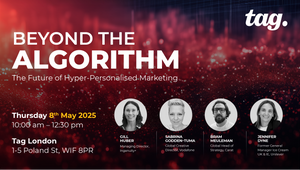
The Role of Algorithms in Advertising Strategy and the Creative Rebellion Ahead

With over half of global ad spend already controlled by algorithms and projections showing that this is set to increase to 80% by 2027, the advertising industry is undoubtedly in its algorithmic age. But while machines are increasingly in charge of message delivery, human creativity is proving more vital than ever in determining what those messages say – and how they make people feel.
At a recent panel hosted by Tag and moderated by the Ingenuity Group, leaders from Carat, Tag and ex-Unilever discussed balancing data precision with emotional resonance in advertising.
\“AI and algorithms shape what we see, how we connect, and even how culture forms,” said Bram Meuleman, global head of strategy at Carat. “The good news is, AI also brings opportunities – true human understanding, touchpoint relevance, and full budget accountability. But the playing field is flatter than ever. Most marketers are using the same platforms, same data pools, and same tools. So how you use the data is everything.”

Gone are the days when owning unique data sources gave brands a competitive edge. In today’s landscape, differentiation comes not from what data you have, but how creatively you apply it.
Jennifer Dyne, former GM of Ice Cream at Unilever, framed algorithmic marketing as necessary, but not novel. “If you’re not doing hyper-personalised marketing already, you're behind. But relevance alone doesn’t cut it. We need to return to marketing’s magic: connection, emotion, memorability.”
The panel unanimously agreed that the challenge with personalisation lies in making it meaningful – which is why empathy and not just efficiency is required. Tag storyteller and strategist Dan Davies put it succinctly: “You’ve got to marry artificial intelligence with emotional intelligence.”
The pressure to be everywhere, instantly, can drown brands in data. But the panel warned against mistaking volume for value.
“Marketers are overloaded with dashboards,” said Dan. “But how many have actually spoken to a real customer lately? Data should enable, not dominate.”
But to do this well, brands need to rethink their dependency on tech-driven insights. “There’s no single right answer anymore,” said Bram. “Just thousands of possible answers. What matters is execution and the ability to act on insight fast.”
While the product is what consumers see, the panelists encouraged marketers to embed creativity across the entire planning process – from insight generation to media strategy. “We’ve reduced comms planning to targeting,” continued Bram. “But relevance comes from understanding context, group identities, and culture. That’s where planning becomes truly creative.”
If algorithms optimise for perfection, people respond to imperfection. “Flaws are interesting,” said Dan. “They’re human. And creativity thrives in that space.”
The panelists suggested pushing back on marketing ideas that are too polished, programmatic, or predictable, citing the legacy of various campaigns exactly because they don’t play by data’s rules – they play on emotion instead. Data can point you to the moment, but creativity will help to make it stand out.

“People don’t just want to be understood anymore,” said Dan. “They want to see themselves in your brand. We’re not just personalising messages – we need to let consumers personalise us.”
Which requires brands to shift away from dictating culture and toward co-creating meaning in their consumer’s world. Marketers must resist the temptation to chase algorithmic optimisation at the expense of originality.
“There’s a massive opportunity to rethink the entire model,” said Bram. “From how we structure creative and production, to how we plan communications and execute at speed.”
Automation is now occupying the space previously dedicated to repetitive tasks, but Jennifer encouraged brands to use that time wisely: “Reinvest it in creativity, in understanding your audience deeply, in asking better questions.”
Or as she put it when asked what she'd do with 20% of her budget returned: “I’d put it into one big, bold, disruptive campaign – with no KPIs and no action standards attached.” Because in an age when everything can be measured, maybe the most powerful thing a brand can do is something immeasurable.















